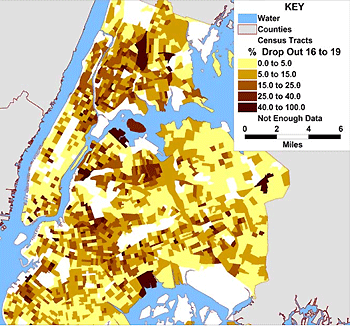For at least 50 years, business leaders, politicians and parents berated students to “Stay In School.” Dropping out of high school condemned one to a life of economic uncertainty, welfare dependency or worse. Low dropout rates for high schools became a measure of school success, while high dropout rates were signs of failure. Where retention rates determined success, schools were expected to get all students to the goal of a high school diploma.
Recently “accountability” trends in education policy, culminating in the Bush administration’s ”No Child Left Behind” legislative mandate have shifted the focus from dropout rates to test performance. The results of such tests now determine which schools are “failing” and which are “succeeding.” Administrative actions to “restructure” failing schools and to let the students choose other schools hang in the balance. In New York State, the newly revised Regents Exams is to become the graduation standard, despite the recent flap concerning the scoring of the mathematics exam and the recent and the continuing 55 percent passing grade. In effect, New York State and City already grade high schools based upon the students who can be tracked from 9th grade to 12th grade. The percentage of students who graduate in four years is computed. However, students who transfer out often are not found in these figures, and many of them could be dropouts stop-outs or push-outs. Though New York State does not report, “dropout rates” per se, many individual schools often do give their dropout rate. Yet, no school knows its true dropout rate unless it knows where every single non-returning student goes.
Recent stories in the New York Times plainly show that attempts to cut the test failure rate increased the number of students pushed out of school in both New York City and Houston, which is the school district that Lod Paige, US Secretary of Education, used to lead. But the practice of students being dropped from the rolls in Houston and then inaccurately reported as transfers seems also to be popular in New York City. Because of such misleading reporting measuring dropout rates becomes even more elusive. Though a very well known phenomena among education insiders, these discrepancies in reporting dropout rates are hidden from the public.
The Census Bureau provides an excellent measure of dropouts. Instead of asking school administrators for a number saying how many students dropped out and computing a rate based upon enrollment, the census tabulates the number of persons 16 to 19, who do not have a high school diploma and who are not enrolled in school. From this one can easily figure out what the proportion of dropouts or non-attendees there are. According to the 2000 Census one finds that the 11.05 percent dropout rate in NYC is somewhat higher than the New York State rate of 8.77 percent. For non-Hispanic Whites the rate is 4.51 compared to the state rate of 5.31 percent. For Hispanics both the city and state rate is 18.08 percent, while for blacks the rate is 10.65 percent, slightly lower than the state’s 11.33 percent. Simply put, the dropout rate for Hispanics is about four times that for whites in New York City, while the rate for blacks is more than double that for whites.
Though it is based upon the neighborhood or city of residence (census tract or larger area), such a dropout rate becomes a very good measure in a setting where virtually all students go to public schools. Where many chose private or parochial school, the public schools still are the “last resort,” since they are obligated to take all comers. Since it is computed for most census areas, it also can directly compare one jurisdiction with another.
Many educators despise this measure. Indeed, an official at the National Center for Education Statistics, which includes it in their census compilation of school district data, told me that an urban school administrator threatened to kill himself (they assumed he was joking but he was very upset) if they continued to include it. Yet, the patterns that the census finds become quite telling and raise an issue not usually addressed: To what extent is dropping out of school a school- based phenomenon? In other words, to what extent can schools affect dropout rate? Or do some students from some areas just have a high propensity to leave school without a diploma. The accompanying map shows the dramatic variations in dropout rate among neighborhoods. Dropout rates are more than 25 percent in the South Bronx, around Flatbush in Brooklyn, and also in areas of high immigrant concentration in the Corona area in Queens. Can one really expect schools in such areas with highly mobile populations of limited means and many of them non-English speakers, to have dropout rates as low as those in Bayside, Queens in the affluent portions of Manhattan and Staten Island, in Riverdale, and in Forest Hills?

From “stay in school” initiatives to performance tests, officials recognize a high school diploma and the skills associated with it as vital to a student’s full participation in society. The judicial ruling (in PDF format) in the Campaign for Fiscal Equity case makes this plain and a right. The new trend in grading schools by test scores and holding administrators accountable for them may encourage educators to get rid of the poorly performing students. Using the census data on dropouts, soon to be available on a continuous basis from the census bureau, will allow educators and concerned citizens to monitor dropouts more honestly.
Andrew A. Beveridge has taught sociology at Queens College since 1981. Since 1993 he has done demographic analyses and consulted for the New York Times. He has provided expert testimony in districting and redistricting, housing discrimination, and numerous other civil rights cases in the metropolitan area and elsewhere. The opinions expressed in Topics are his alone.




